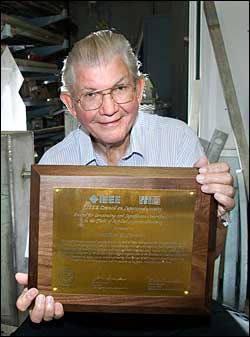Home > Press > Brookhaven Lab Physicist William Sampson Receives IEEE Award for Applied Superconductivity Research
 |
| William Sampson |
Abstract:
William Sampson, a senior physicist at the U.S. Department of Energy's Brookhaven National Laboratory, has received the IEEE Council on Superconductivity Award for Significant and Sustained Contributions in the Field of Applied Superconductivity.
Brookhaven Lab Physicist William Sampson Receives IEEE Award for Applied Superconductivity Research
Upton, NY | Posted on August 13th, 2010For 48 years, Sampson has helped to design and build superconducting magnets that keep particle beams circulating in accelerators, such as Brookhaven Lab's Relativistic Heavy Ion Collider (RHIC). He received the award, which consists of a plaque; a medallion made of niobium, a superconducting material; and $5,000, on August 2, at the Applied Superconductivity Conference in Washington, D.C.
"I'm glad that my contributions to the development of superconducting magnets are being recognized," Sampson said. "I hope to continue to contribute to the field for many years to come."
Superconducting magnets are made of conductors that can carry electric current without power dissipation at very low temperatures. In particular, the IEEE honored Sampson for his contributions to the field of large-scale superconductivity. In the 1960s, he built some of the first superconducting magnets to exceed 10 Tesla, 200,000 times the earth's magnetic field.
Sampson also made early models of dipole and quadrupole magnets, used for bending and focusing beams of particles in accelerators. Accelerators around the world, including RHIC and the Large Hadron Collider (LHC) at CERN, the European Organization for Nuclear Research, have benefited from this pioneering work.
In the 1970s, Sampson made magnets called "wigglers" for the NSLS, which began operating in 1982. Annually, about 2,300 scientists use x-rays, infrared and ultraviolet light at the synchrotron to study materials as diverse as computer chips and viruses. Wiggler magnets force the electron beam in a light source to move, or wiggle, due to high local magnetic fields, giving rise to increased energy in the emitted light. This type of magnet will also be used in the Laboratory's NSLS-II, a light source 10,000 times brighter than the NSLS, now under construction and due to be in operation by 2015.
Sampson has also worked on high-temperature superconducting magnets that can operate in high radiation environments, such as the future U.S. Department of Energy-funded Facility for Rare Isotope Beams (FRIB), a nuclear physics facility that will be operated by Michigan State University. FRIB is expected to provide scientists with information about the properties of rare isotopes - short-lived nuclei not normally found on earth - that should help them to better understand the origin of elements and evolution of the cosmos.
Currently, Sampson is developing very high-field superconducting magnets that may be used in building a high-energy muon collider. A team of physicists is examining the feasibility of such a collider, which would enable scientists to make detailed studies of particles found at the LHC.
After earning a Ph.D. in physics from the University of Toronto in 1962, Sampson joined Brookhaven Lab as an assistant physicist. He was promoted to physicist in 1967 and to senior physicist in 1977.
####
About Brookhaven National Laboratory
One of ten national laboratories overseen and primarily funded by the Office of Science of the U.S. Department of Energy (DOE), Brookhaven National Laboratory conducts research in the physical, biomedical, and environmental sciences, as well as in energy technologies and national security. Brookhaven Lab also builds and operates major scientific facilities available to university, industry and government researchers. Brookhaven is operated and managed for DOE's Office of Science by Brookhaven Science Associates, a limited-liability company founded by Stony Brook University, the largest academic user of Laboratory facilities, and Battelle, a nonprofit, applied science and technology organization.
For more information, please click here
Contacts:
Diane Greenberg
(631) 344-2347
Peter Genzer
(631) 344-3174
Copyright © Brookhaven National Laboratory
If you have a comment, please Contact us.Issuers of news releases, not 7th Wave, Inc. or Nanotechnology Now, are solely responsible for the accuracy of the content.
| Related News Press |
News and information
![]() Simulating magnetization in a Heisenberg quantum spin chain April 5th, 2024
Simulating magnetization in a Heisenberg quantum spin chain April 5th, 2024
![]() NRL charters Navy’s quantum inertial navigation path to reduce drift April 5th, 2024
NRL charters Navy’s quantum inertial navigation path to reduce drift April 5th, 2024
![]() Discovery points path to flash-like memory for storing qubits: Rice find could hasten development of nonvolatile quantum memory April 5th, 2024
Discovery points path to flash-like memory for storing qubits: Rice find could hasten development of nonvolatile quantum memory April 5th, 2024
Announcements
![]() NRL charters Navy’s quantum inertial navigation path to reduce drift April 5th, 2024
NRL charters Navy’s quantum inertial navigation path to reduce drift April 5th, 2024
![]() Discovery points path to flash-like memory for storing qubits: Rice find could hasten development of nonvolatile quantum memory April 5th, 2024
Discovery points path to flash-like memory for storing qubits: Rice find could hasten development of nonvolatile quantum memory April 5th, 2024
Grants/Sponsored Research/Awards/Scholarships/Gifts/Contests/Honors/Records
![]() Discovery points path to flash-like memory for storing qubits: Rice find could hasten development of nonvolatile quantum memory April 5th, 2024
Discovery points path to flash-like memory for storing qubits: Rice find could hasten development of nonvolatile quantum memory April 5th, 2024
![]() Chemical reactions can scramble quantum information as well as black holes April 5th, 2024
Chemical reactions can scramble quantum information as well as black holes April 5th, 2024
|
|
||
|
|
||
| The latest news from around the world, FREE | ||
|
|
||
|
|
||
| Premium Products | ||
|
|
||
|
Only the news you want to read!
Learn More |
||
|
|
||
|
Full-service, expert consulting
Learn More |
||
|
|
||








